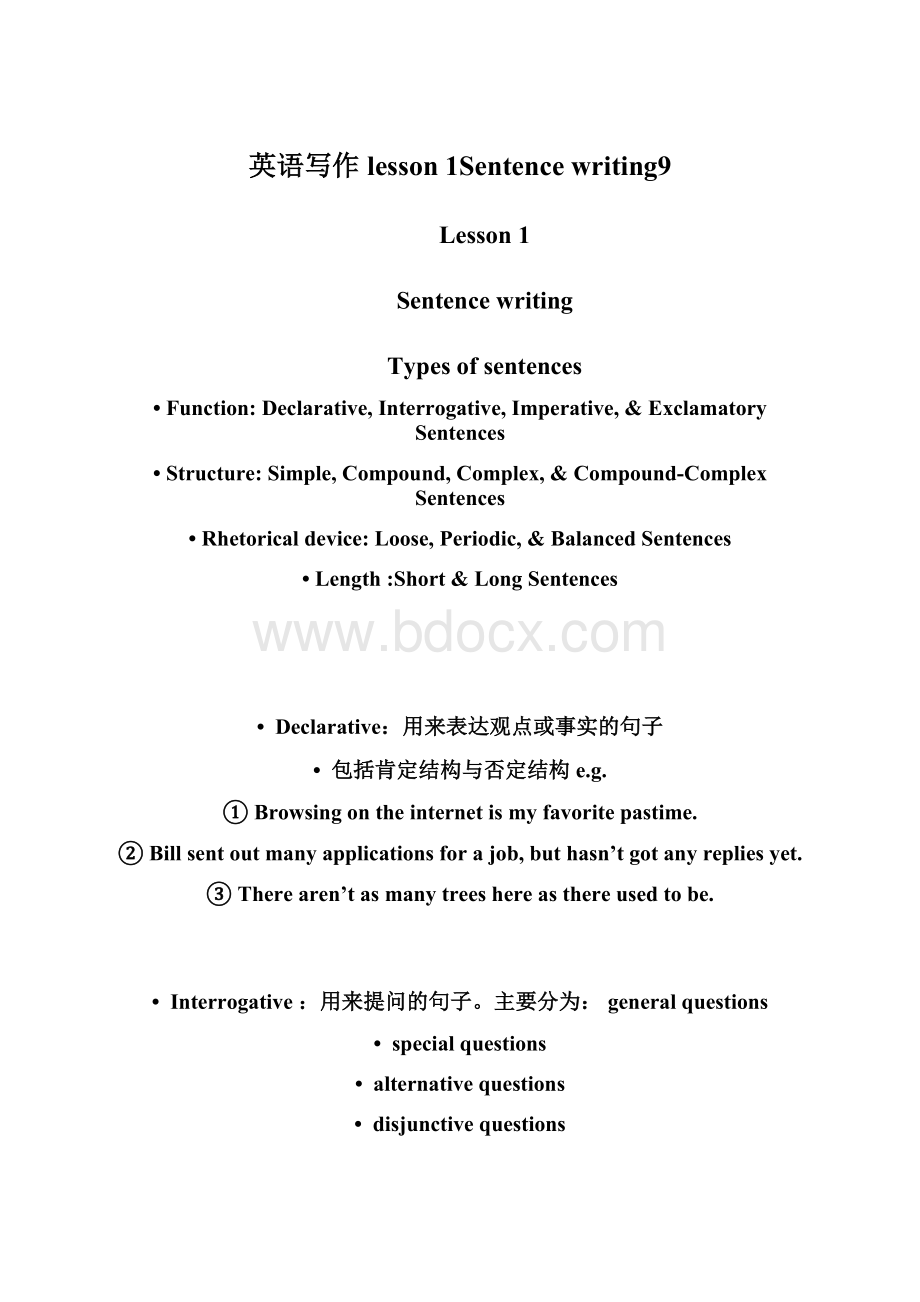英语写作lesson 1Sentence writing9Word格式.docx
《英语写作lesson 1Sentence writing9Word格式.docx》由会员分享,可在线阅读,更多相关《英语写作lesson 1Sentence writing9Word格式.docx(30页珍藏版)》请在冰豆网上搜索。

•disjunctivequestions
•e.g.
•Isn’ttheneweditionofthisbookmoreexpensivethanitsoldedition?
•Didyouhearaboutthenewproject?
•What’stoday’sexchangerateforUSdollarsagainstJapaneseyen?
•Theyoungsters’valuesarequitedifferentfromtheirparents’atpresent,aren’tthey?
•Imperative:
用来表达命令、要求、请求、劝告或建议。
祈使句的主语一般是第二人称you,在句中通常省略。
祈使句的谓语用动词原型,其否定结构为“don’t+动词原型”。
句末一般使用句号或感叹号。
•Besuretotakeyourpersonalbelongingsbeforegettingoffthetrain.
•Let’snotwasteourtimearguingaboutthecurrenttopic.
•Don’thesitatetogivemeacallifyouhaveanyproblem.
•Exclamatory:
用来抒发强烈感情的句子。
如抒发喜悦、赞叹、惊异、愤怒、厌恶、痛苦知青等,句末用感叹号。
what用来修饰名词;
how用来修饰形容词、副词或动词。
E.g.
•Whatagreatideaitis!
•Howbeautifulthesceneryis!
•Howfastthingsarechanginghere!
Whatmakesasentence?
•Sentenceelements
•Subject
•predicateorpredicateverb
•objective/predicative/compliment
•Attribute
•Adverbial
•appositive
•independentelementofthesentence
Elementsofsentences
Essentialelements
主语(subject)
•主语是句子的主体,是句子所要说明的人或事物,表示句子描述的是“谁”或“什么”。
•通常由名词,代词,数词,动词不定式,动名词或主语从句担任。
•其位置在陈述句基本结构的前部
♦Ireadnewspapereveryday.
♦Threeplussixisnine.
4.Tobecomeaprofessorhasbeenhisambition.
5.Smokingisharmfultohealth.
6.Whatweshalldonextisnotyetdecided.
谓语(predicate)
•谓语是说明主语的动作或状态的部分。
•谓语一般由动词或动词短语担任。
•其位置在主语之后
♦Hismotherisadoctor.
♦WeshouldpayattentiontoEnglishidioms.
♦WestudyEnglish
表语(predicative)
•表语是在联系动词之后表示主语的性质,特征,状态或身份的部分。
•通常由名词,代词,形容词,副词,介词短语以及动词不定式,动名词,分词或表语从句担任
•位置在联系动词之后
♦Hisfatherisalawyer.
♦Yournumberis42.
♦Allthepupilsareontheground.
宾语(object)
•宾语表示及物动词的对象或内容。
介词后面的名词或代词叫做介词宾语。
•通常由名词,代词,数词或与之相当的结构担任
•位置在及物动词或介词之后
♦Heboughtacomputerlastyear.
♦Wehelpeachotherandlearnfromeachother.
•一个句子可以包含两个宾语:
直接宾语(directobject)和间接宾语(indirectobject)。
•直接宾语一般指动作的承受者,多为物。
•间接宾语指动作指向的对象,多为人。
•双宾语的常用句型为:
主语+及物动词+间接宾语+直接宾语。
•间接宾语也可改为由介词引起的短语,放在直接宾语的后面。
如:
•Shepassedhimthesalt.
•=Shepassedthesalttohim.
补语(complement)
•补语用来补充主语和宾语的意义的,一般都注重说明主语或宾语的特征。
•通常由形容词,名词或其他相当的结构担任。
•分为宾语补足语和主语补足语
♦Thegovernmentappointedherchiefdelegatetotheconference.
♦Hewasfoundsilentinoffice.
定语(attributive)
•定语用于限定或修饰名词或代词
•由形容词或其相当的结构
•单词做定语一般放在修饰语的前面,短语和从句做定语则放在被修饰语的后面。
♦Heisanhonestandhardworkingboy.
♦Ihavesomethingimportanttotellyou.
♦Thosewhowanttogomaygo.
♦Thegirlplayingtheviolin
isafresher.
状语(adverbial)
•状语用于修饰动词,形容词,副词或整个句子。
•通常由副词或与之相当的结构
•修饰形容词或副词的状语放在被修饰语之前;
修饰动词的状语有的放在动词之前,有的放在之
后。
如动词有宾语,状语
一般放在宾语之后。
♦ShespeaksEnglishquitewell.
♦Hehasbeeninthehospitalforoveraweek.
♦IfIhavesomesparetime,IwilltakeupGerman.
同位语(appositive)
•在由两个或两个以上的语法单位组成的结构中,如果其中的前项与后项所指相同,句法功能也相同,那么后项被称为前项的同位语。
•同位语位于名词或名词性短语之后,说明其内容。
同位语通常由名词,名词性短语或从句担当。
♦Thefuturebelongstoyouyoungpeople.
♦Theyeachhaveadictionary.
♦People,oldandyoung,wenttothestreetstowatchtheparade.
•句子独立成分(independentelementofthesentence)。
它与全句没有语法关系,如感叹词、称呼语和插入语等。
•Tobefrank,Idon’tthinkyoutwoarecomparable.
Analyzethefollowingsentences.
1.Thesailorsawthattheshipwassinking.
2.Thethoughtthathelpwasnearkeptourspiritsup.
3.Myopinionisthatthisstoryisfalse.
4.Hiseducationhasmadehimwhatheisnow.
5.ThefirstthingI’mgoingtodothiseveningistovisitmyformerteacher.
Basicsentencepatterns
•Subject+Verb
•Subject+Verb+Predicative/compliment
•Subject+Verb+Object
•Subject+Verb+Object+Complement
•Subject+Verb+indirectObject+directObject
•Subject+Verb+Adverbial
•Subject+Verb+Object+Adverbial
(1)SV句型(Subject+IntransitiveVerb)
•SV句型是最基本的简单句句型,可简称为主谓结构。
•Thingschange.
•ManycarownersinAmericabelongtotheAmericanAutomobileAssociation
•There+be结构是一种较常见的特殊句子结构,可看作是SV举行的一种变体。
•e.g.
•There’sawiderangeofcurrentandbackissuejournalsinouruniversitylibrary.
•Thereisnoseriousproblemtocontrolthetemperature.
(2)SVCs句型
↙↓↘
主语系动词主语补足语/表语
•
e.g.
•Hardworkandhonestyarethekeystosuccess.
•Itisatraditionalcustomtoeatmoon-cakesduringtheMid-AutumnFestival.
•Withoutsuitablepreservation,foodgoesbadeasily.
(3)SVO句型
主语及物动词动词宾语
•这种结构可简称为主谓宾结构。
名词、代词、数词、动名词(短语)、不定式(短语)或从句都可在句中充当宾语。
•TheyoungestskaternearlywonagoldmedalinthelastWinterOlympicGames.
•Studentsoftenreciteusefulphrasestobeusedintheircompositions.
•Ihavetocheckmye-maileveryotherday.
(4)SVOCo
↓
宾语补足语
适于此句型的常见动词有:
believe,call,consider,cut,elect,find,have,keep,leave,let,like,make,name,polish,think,want,wish
宾语补足语可以由名词、形容词、副词、分词(短语)、不定式(短语)、介词(短语)等构成。
•不定式作宾补---
表达和强调已发生的事实
•现在分词作宾补---
表达和强调正在进行的状态和发生的事情
•过去分词作宾补---
表达和强调被动的概念和状态
•Thebenefitsmakethejobdesirable.
•Theybelieveitimportanttomakeanearlydiagnosisofcancer.
•Sincethefirstconfirmedbirdflucase,ChinahaskepttheBeijingofficeofWHOwellinformed.
自首次确定第一例禽流感以来,中国一直向世界卫生组织驻北京办事处及时通报疫情。
(5)SVOiOd句型
※常用于此句型的动词有:
allow,bring,buy,fetch,get,give,lend,offer,save,sell,send,show,take,wish等
•ThenightsceneinHongKonggivesvisitorsanindelibleimpressionofexcitement.
香港的夜景令游客们激动不已,久久不能忘怀。
•Thebossaccordedhimaheartyreceptioninthenewsalespromotioncampaign.
在这次促销活动中,老板热情地接待了他。
Studythefollowingsentences:
•Stephenapologized.
•Frankisclever/anarchitect.
•Mysisterenjoyedtheplay.
•ThefirmgaveSamawatch.
•TheymadeSamchairmanoftheboard.
•Joeleapedfromtheedgeofhischair.
•AmericaneducationowesagreatdebttoThomasJefferson.
TranslatethefollowingsentencesintoEnglish,usingthecorrectsimplesentences.
1.小皮特正在和爷爷玩。
2.我父亲是位工程师。
3.星期天到了。
4.我们选举他为班长。
5.他喜欢收集邮票。
6.琼在信里告诉了父母她的校园生活。
1.LittlePeterisplayingwithhisgrandpa.
2.Myfatherisanengineer.
3.Sundaycomes/iscoming.
4.Weelectedhimthemonitor.
5.Helikescollectingstamps.
6.Joantoldherparentsabouthercampuslifeintheletter.
•Structure
•simple简单句,
•compound并列句,
•complex复合句,
•compound-complex,并列复合句
简单句SimpleSentence
是只包含一个主谓结构的句子。
↙↘
只包含一个主语包含两个或两个以上
和谓语的句子并列的主语或谓语的句子
•Lifeisbeautiful.
•Iwantnothing.
•Ienjoyplayingbadmintonandlookforwardtoiteveryweekend.
•MyfriendsandIoftenplaygolfandgobowlingonholidays.
•Employersvalueclearwriting.
•Employersvalueclearwritingbutmaynotmentionthisdirectly.
•Bothemployersandacademicsvalueclearwriting.
•simplesentencesarenotalwaysshortsentences,anditdoesn’tmeansimplesentencescannothaveattributiveoradverbials.
•e.g.
•MaryismajoringineconomicsatHarvardUniversity.
•Likemanyotheradventurers,hehasexperiencedfearandconqueredit.
•Ilikethemoviedescribingthewonderfulandexcitinglifeofthelegendarywriter.
简单句的特点(从文体修辞上看)
1.短小精悍,结构简单,表意明确,具有明显的强调功能。
Christmaswascoming.Iwanted
apony.Iwantednothingelsebutapony.
2.描述一连串快速进行的动作,不带任何修饰语,制造出一种紧张激烈,扣人心弦的气氛。
Hedid.Heransprints,heranhurdles,herandistanceraces.Hehigh-jumped,helong-jumped.Hethrewthejavelinandtheshot.Finishingfirstineightevents,thebigfellowbeatthewholeteam.
3.连续使用,还可以产生干脆利落,铿锵有力的表达效果。
PeoplethinkIamfoolishandignorant,butI’mnot.Ilisten.Ihear.Isee.Ithink.Iread.Iwalkalonebymyself.
•Icame.Isaw.Iconquered.
•简单句使文章有一种不支不蔓,简洁明快的风格。
但是他也有局限:
容量小,不易表达复杂,细腻的思想或说理过程;
过多使用还会使文章显得单调,幼稚。
区分简单句和省略句
•省略句是在表面结构上不完整,不是主谓结构,但从上下文看意思却很清楚的句子。
•省略句和简单句一起来描写激动的心情或紧张的场面
Ihardlyheard,Icouldscarcelywait.I
Wassohappy,sothrilled.Irodeoffup
thestreet.Suchabeautifulpony.Andmine!
并列句(CompoundSentence)---Acompoundsentencecombinestwo(ormore)simplesentences
Thesetwosentencesareclearlyrelatedandofequalimportance
•包含两个或两个以上互不依从的主谓结构的句子
•意义上,各分句是同等重要并密切相关的
•语法结构上,各分句是结构完整且相互间平行没有从属关系的
•Testprovidesgrades,andtheworldwon’tendifyoudon’tpassasingletest.
•Testprovidesgrades,buttheyalsoletyouknowwhatyouneedtospendmoretimestudying.
各分句常用一定的并列连词、连接副词和分号连接在一起
•Ihatejogging,butIlovehiking.
•Punctuationisimportant;
therefore,don’tforgettouseacommabeforethecoordinatingconjunctioninacompoundsentence.
•ThisisthebestbookIhaveeverread;
itkeptmeupallnight.
简单句→并列句
•(comma+)Coordinatingconjunctions并列连词(for,and,nor,but,or,yet,so)
•或者关联并列词:
notonly…butalso,etc
Employersvalueclearwriting,buttheymaynotmentionthisdirectly.
•两个单句很短,或意思非常紧密,可无需用逗号分隔。
•Iturnedonthekeybuttheenginewouldn’tstart.
2.Asemi-colon在不用并列连接词的情况下使用分号连接
(iftherelationshipissoclearthatalinkingwordisunnecessary)
•Employersvalueclearwriting;
this,infact,isof